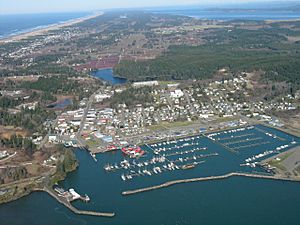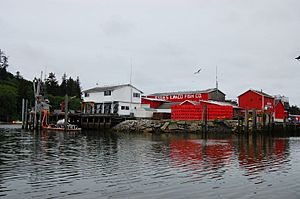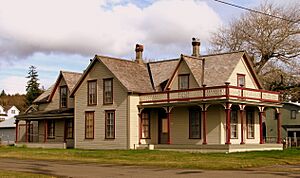Ilwaco, Washington facts for kids
Quick facts for kids
Ilwaco
|
|
|---|---|
| Ilwaco, Washington | |

Aerial view of Ilwaco and Ilwaco Harbor. The western edge of Long Beach Peninsula is on the left, and cranberry bogs are visible immediately north of downtown Ilwaco.
|
|

Location of Ilwaco, Washington
|
|
| Country | United States |
| State | Washington |
| County | Pacific |
| Area | |
| • Total | 5.78 sq mi (14.97 km2) |
| • Land | 2.07 sq mi (5.35 km2) |
| • Water | 3.71 sq mi (9.61 km2) |
| Elevation | 23 ft (7 m) |
| Population
(2020)
|
|
| • Total | 1,087 |
| • Density | 188.06/sq mi (72.61/km2) |
| Time zone | UTC-8 (Pacific (PST)) |
| • Summer (DST) | UTC-7 (PDT) |
| ZIP code |
98624
|
| Area code(s) | 360 |
| FIPS code | 53-33000 |
| GNIS feature ID | 1521144 |
| Website | City of Ilwaco |
Ilwaco (say il-WAH-koh) is a city located in Pacific County, Washington, United States. In 2020, about 1,087 people lived there.
The city was founded in 1890. It was once home to the Ilwaco Railway and Navigation Company. Ilwaco's main industries were logging and moving timber on rivers. The city is on the southern tip of the Long Beach Peninsula. It sits on Baker Bay, where the Columbia River meets the Pacific Ocean. Ilwaco is also close to Astoria, Oregon, which is across the Columbia River to the southeast.
Contents
History of Ilwaco
Ilwaco was first settled in 1851 by Henry Feister. It was originally called Unity. The city was named after a Lower Chinook leader named Elwahko Jim. His native name was [ʔɪlwəkʷo]. He was the son-in-law of Chief Comcomly. Ilwaco officially became a city on December 16, 1890.
The Ilwaco Railway
A special kind of train track, called a narrow gauge railway, ran through Ilwaco for over 30 years. This railway was part of the Ilwaco Railway and Navigation Company. It helped move goods and people around the area.
The train tracks went north along First Street in Ilwaco. The railway had special areas for trains, like a turntable to turn them around. There was also a place to fill the trains with water. The main train station was built on Spruce Street. A side track was added for the Ilwaco Mill and Lumber Company.
The passenger station was on the west side of First Street. Trains would even go out onto the dock in Ilwaco. Logs were kept in the water behind special barriers near the dock. First Street was covered with wooden planks until 1916, when it was paved. By 1915, more businesses had opened along First Street.
Recent Events: The 2024 Fire
On January 22, 2024, a large fire started at the Ilwaco Landing. This is part of the Port of Ilwaco. The fire destroyed a dock and a building used for receiving goods. It also burned about 600 crab pots. This happened just a few days before the start of the fishing season.
Geography and Climate
Ilwaco is located on the Long Beach Peninsula. The city covers about 5.93 square miles (14.97 square kilometers). Most of this area, about 3.83 square miles (9.61 square kilometers), is water. The land area is about 2.10 square miles (5.35 square kilometers).
What is Ilwaco's Climate Like?
Ilwaco has a cool oceanic climate. This means it has mild temperatures. Summers are warm but not too hot. They are also somewhat dry. The average monthly temperature never goes above 71.6 °F (22 °C). Snow is not common, even in winter.
| Climate data for Ilwaco, Washington | |||||||||||||
|---|---|---|---|---|---|---|---|---|---|---|---|---|---|
| Month | Jan | Feb | Mar | Apr | May | Jun | Jul | Aug | Sep | Oct | Nov | Dec | Year |
| Record high °F (°C) | 65 (18) |
75 (24) |
79 (26) |
86 (30) |
94 (34) |
97 (36) |
100 (38) |
102 (39) |
99 (37) |
88 (31) |
69 (21) |
63 (17) |
102 (39) |
| Mean daily maximum °F (°C) | 48.9 (9.4) |
50.7 (10.4) |
53.3 (11.8) |
56.3 (13.5) |
60.2 (15.7) |
63.5 (17.5) |
67.1 (19.5) |
68.0 (20.0) |
67.2 (19.6) |
60.1 (15.6) |
52.3 (11.3) |
47.9 (8.8) |
58.0 (14.4) |
| Mean daily minimum °F (°C) | 37.4 (3.0) |
36.9 (2.7) |
38.7 (3.7) |
40.7 (4.8) |
45.4 (7.4) |
49.5 (9.7) |
52.7 (11.5) |
52.6 (11.4) |
48.8 (9.3) |
44.0 (6.7) |
39.9 (4.4) |
36.7 (2.6) |
43.6 (6.4) |
| Record low °F (°C) | 5 (−15) |
5 (−15) |
20 (−7) |
24 (−4) |
28 (−2) |
34 (1) |
37 (3) |
35 (2) |
29 (−2) |
17 (−8) |
9 (−13) |
3 (−16) |
3 (−16) |
| Average precipitation inches (mm) | 11.65 (296) |
9.89 (251) |
9.01 (229) |
5.92 (150) |
3.86 (98) |
3.05 (77) |
1.64 (42) |
1.68 (43) |
3.33 (85) |
6.83 (173) |
11.83 (300) |
12.49 (317) |
81.18 (2,061) |
| Average snowfall inches (cm) | 0.4 (1.0) |
0.6 (1.5) |
0 (0) |
0 (0) |
0 (0) |
0 (0) |
0 (0) |
0 (0) |
0 (0) |
0 (0) |
0.2 (0.51) |
0.3 (0.76) |
1.5 (3.8) |
People of Ilwaco
| Historical population | |||
|---|---|---|---|
| Census | Pop. | %± | |
| 1880 | 85 | — | |
| 1890 | 517 | 508.2% | |
| 1900 | 584 | 13.0% | |
| 1910 | 664 | 13.7% | |
| 1920 | 787 | 18.5% | |
| 1930 | 750 | −4.7% | |
| 1940 | 656 | −12.5% | |
| 1950 | 628 | −4.3% | |
| 1960 | 518 | −17.5% | |
| 1970 | 506 | −2.3% | |
| 1980 | 604 | 19.4% | |
| 1990 | 815 | 34.9% | |
| 2000 | 950 | 16.6% | |
| 2010 | 936 | −1.5% | |
| 2020 | 1,087 | 16.1% | |
| U.S. Decennial Census 2020 Census |
|||
What is Ilwaco's Population Like?
According to the 2010 census, 936 people lived in Ilwaco. There were 443 households, which are groups of people living together. About 257 of these were families. The city had about 445.7 people per square mile.
Most of the people in Ilwaco were White (89.9%). There were also small numbers of African American, Native American, and Asian residents. About 5.7% of the population was Hispanic or Latino.
About 21.2% of households had children under 18. Many households (46.7%) were married couples. The average household had 2.11 people. The average family had 2.68 people.
The average age in Ilwaco was 50.2 years old. About 16.7% of residents were under 18. About 21.6% were 65 or older. The city had slightly more males (51.5%) than females (48.5%).
Arts and Culture in Ilwaco
Historic Places to Visit
Ilwaco has two important places listed on the National Register of Historic Places. These are special places recognized for their history.
- Cape Disappointment State Park: This is a public park where people can enjoy nature and learn about history.
- Colbert House: This historic house is also a Washington State Parks Heritage Site.
The old Ilwaco freight depot, a building where goods were stored for the train, has been moved. It is now part of the Columbia Pacific Heritage Museum.
Ilwaco's Economy
Ilwaco's economy started with using natural resources. This included cutting down trees for timber and fishing. It became known as a sawmill and fishing town. People caught a lot of seafood there.
One fish processing company in Ilwaco handled a large amount of the state's commercial fish catch in 2023. However, the fire at the port in 2024 greatly reduced the city's seafood processing ability. Now, the city has only one working facility to receive fish.
Besides logging and fishing, Ilwaco has also been known for growing cranberries. You can see cranberry farms just north of the downtown area.
See also
 In Spanish: Ilwaco (Washington) para niños
In Spanish: Ilwaco (Washington) para niños
Images for kids






